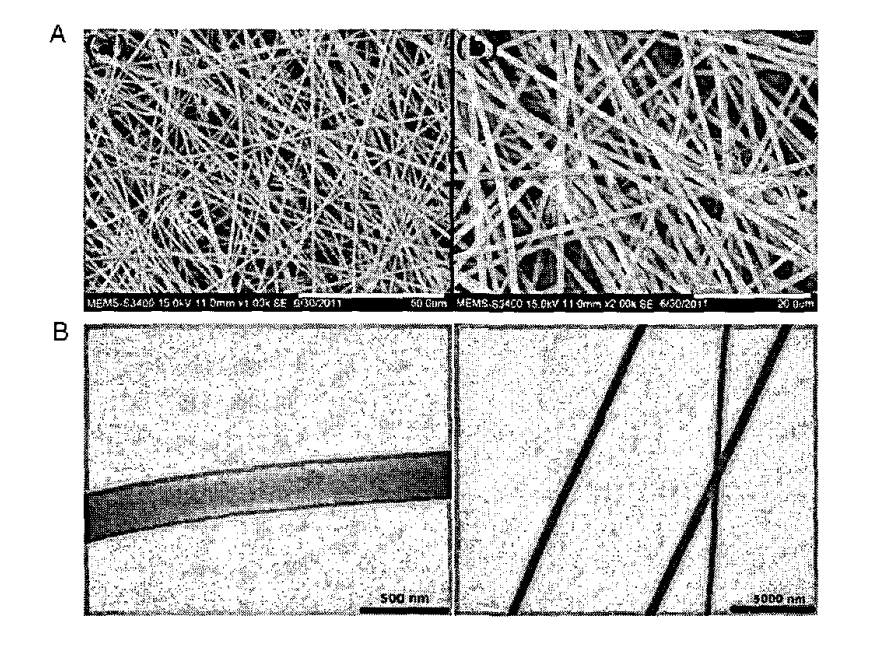The technology is a PCG-based electrospun nanofiber scaffold that serves as both a growth platform and delivery system for BMPCs. Designed for direct application to wounds, it enhances cell proliferation, viability, and chemotactic migration, ensuring efficient and scar-free healing in diabetic or burn wounds.
Figure (1A) SEM images depict morphology of electrospun PCG nanofibers showing random orientation and smooth morphology – figure on left shows 1000 X magnification (scale bar = 50 µm) and figure on right shows 2000 X magnification (scale bar = 20 µm); (1B) TEM images of electrospun nanofiber of PCL/Gelatin showing smooth surface (figure on left shows scale bar at 500 nm while figure on right shows scale bar at 5000 nm.
Chronic, non-healing wounds-particularly those resulting from diabetes or burns-pose severe health risks, including amputations and infections. Traditional scaffolds either support blood/bone marrow precursor cell (BMPC) delivery or growth but rarely both, limiting clinical efficiency in wound healing.
- One-Step Growth and Delivery: A unique scaffold enabling direct growth, enrichment, and delivery of BMPCs without intermediate isolation or culture.
- Biocompatible Nanofiber Matrix: Electrospun polycaprolactone-gelatin (PCG) in a 3:1 ratio providing strength, flexibility, porosity, and cell compatibility.
- Enhanced Healing: It promotes focal adhesion-mediated BMPC attachment, sustained chemotactic migration, and accelerated scar-free wound repair.
- Cryopreservable and Easy to Use: It is a ready-to-use “bandage” form that can be cryopreserved and applied post-thaw without loss of efficacy.
Electrospun nanofiber matrix was created using polycaprolactone and gelatin (3:1), seeded with murine BMPCs, cultured in EGM2 medium, and tested in diabetic mice. SEM and TEM analysis confirms optimal fiber morphology (400–700 nm diameter). In vivo testing showed accelerated healing and hair follicle regrowth.
Preclinical studies have been completed, and the technology is now ready for pilot human trials.
5
This technology addresses a critical need in diabetic wound management, reducing hospitalization time, surgical interventions, and healthcare costs. It also offers veterinary applications for wound care in animals such as racing horses.
- Wound Care and Healing: Supports efficient and accelerated healing of acute and chronic wounds by promoting cell growth and sustained delivery directly to the injury site
- Diabetic Ulcer Treatment: Offers an effective solution for non-healing diabetic ulcers by enhancing BMPC activity, reducing the risk of infection, amputation, and prolonged hospital stays
- Post-surgical Healing: Can be used to aid recovery after surgical procedures by supporting tissue regeneration and minimizing scar formation
- Veterinary Wound Treatment: Suitable for animal care, particularly for treating wounds in high-value animals like racehorses, reducing healing time and complications
- Regenerative Medicine: As a biocompatible and cell-friendly matrix, it has potential use in broader regenerative therapies aimed at tissue repair and cell-based treatments
Geography of IP
Type of IP
3343/MUM/2012
364716

